
Wire Wrapped Wrap Ring
- Category: Classic
- Technique(s): Making Loops, Making Spirals, Wrapping, Twisting
- Skill Level: Beginner
We always love great wire wrapped patterns from our friends and contributors and today we feature a beatutiful Wire Wrapped ring by our good friend, Rhonda Chase. If you love wire wrapping and adding sparkly beads, you will love this easy to create pattern!
This beautiful and sturdy wire wrapped ring features an adjustable band. You don't need to worry about ring sizing, so it's perfect for gift giving!
This beautiful and sturdy wire wrapped ring features an adjustable band. You don't need to worry about ring sizing, so it's perfect for gift giving!
Materials

22 Gauge Square Dead Soft 1/10 Sterling Silver Filled Wire
H10-22SQD
- Lesson Quantity: 2.00 feet
- Purchase Quantity: 5.00 1FT
- Price: $0.79
- Gold Club Price: $0.59

22 Gauge Half Round Half Hard 1/10 Sterling Silver Filled Wire
H10-22HRH
- Lesson Quantity: 2.00 feet
- Purchase Quantity: 5.00 1FT
- Price: $0.34
- Gold Club Price: $0.26

22 Gauge Square Dead Soft Copper Wire
H11-22SQD
- Lesson Quantity: 2.00 feet
- Purchase Quantity: 5.00 1FT
- Price: $0.69
- Gold Club Price: $0.52

Swarovski Crystal Beads

Gemstone Beads
Tools

Flat Nose Wire Pliers
G2-506
- G2-506
- Lesson Quantity: 1.00 pieces
- Purchase Quantity: 1.00 each
- Price: $32.95
- Gold Club Price: $24.71

Round Nose Wire Pliers
G2-507
- G2-507
- Lesson Quantity: 1.00 pieces
- Purchase Quantity: 1.00 each
- Price: $32.95
- Gold Club Price: $24.71

C.H.P Milano Italian Flush Cutter, 5 1/2 Inches
PLR-487.00
- PLR-487.00
- Lesson Quantity: 1.00 pieces
- Purchase Quantity: 1.00 each
- Price: $16.97
- Gold Club Price: $12.73

Stainless Steel Ring Mandrel Sizes 1-15
G7-2
- G7-2
- Lesson Quantity: 1.00 pieces
- Purchase Quantity: 1.00 each
- Price: $32.95
- Gold Club Price: $24.71

Marker -extra fine
- Lesson Quantity: 1.00 pieces
- Purchase Quantity: 1.00 each

12 Inch Stainless Steel Ruler
G7-30
- G7-30
- Lesson Quantity: 1.00 pieces
- Purchase Quantity: 1.00 each
- Price: $2.97
- Gold Club Price: $2.23

1mm cotton cord
- Lesson Quantity: 1.00 feet
- Purchase Quantity: 1.00 each
Instructions
Step 1
Measure: Remember that this ring is adjustable, so don't worry too much if your measurements seem a little off at any point. Take your piece of string and wrap it around your finger or ring mandrel (if you know your size). Go once around and then another time halfway around with each side of the string. Then add 3 additional inches and mark the string. Using a ruler, measure what you just marked off on your string. My length turned out to be 8 inches. It is better to err on the side of cutting too long then not having enough wire when you wrap.



Step 2
Cut: This measurement will be the length of the 22 gauge, square, dead soft wire. Cut six strands of this length. I cut 4 of silver and 2 of copper to make it easier to see the difference in the strands and what is happening with the project. You can design any pattern you like from your wire.
Now cut 5 pieces of half round wire. Make them 2 inches each
Now cut 5 pieces of half round wire. Make them 2 inches each

Step 3
Twist (Optional)
If you want to twist any of the wire, now is the time. This makes a nice decorative element to your design. I twisted the two center copper wires.
If you want to twist any of the wire, now is the time. This makes a nice decorative element to your design. I twisted the two center copper wires.
Step 4
Make a Bundle:
The six square wires will be wrapped together with the short pieces of half round wire into a bundle. The bundle is the base for the ring band. The object is to make a flat strip held together at five points.
The six square wires will be wrapped together with the short pieces of half round wire into a bundle. The bundle is the base for the ring band. The object is to make a flat strip held together at five points.
Pick up one piece of 1/2 round wire and use the flat nose pliers to bend 3-4 mm of the top over. Then angle the bend slightly. Make sure the flat side of the wire is on the inside surface. This will fit neatly around the square wire. Repeat with all the short half round pieces.


Step 5
Next hold the square wires together side-by-side in the pattern you want. You may need to wiggle them around a little to get them to line up. Then hook the bend of the 1/2 round wire over one edge as shown.

Step 6
Give a gentle squeeze with the flat nose pliers to secure. (When wrapping, the front of the wraps should be 90 degrees to the bundle wires. The back of the wraps are usually angled.)


Step 7
Hold the square wire bundle with the flat nose pliers very close to where you will wrap the short pieces around. Start winding the 1/2 round wire around the bundle, but stop every time you make a turn and give the wires a gentle squeeze with the flat nose pliers. Expect to be moving the bundle and the pliers around a lot, changing hands when you need to.


Step 8
Wrap the 1/2 round wire around the bundle this way 4 times and end on the back of the bundle. Cut the excess 1/2 round wire so that it overlaps the back 3 to 4mm.
Starting with the middle wrap and working outward, make five total wraps (fairly evenly spaced), over about 3 inches.
Starting with the middle wrap and working outward, make five total wraps (fairly evenly spaced), over about 3 inches.



Step 9
Shape the Band: When you have a nice, secure, flat bundle with five wraps you can start shaping the ring. Hold the bundle against the ring mandrel with your thumb over the central wrap. Then gently start bending the sides over the ring mandrel.
Bend around the back and up to the other side. There should be a single band in the back of the ring and overlapping bands in front as shown.
Bend around the back and up to the other side. There should be a single band in the back of the ring and overlapping bands in front as shown.







Step 10
Fan out the Wires: I like to gently fan out the wires to see exactly what I have to work with.


Step 11
Get Artistic: Now it's time to add embellishments and finish the ends. You can use the following suggestions or use your own favorite wire techniques.
Making filigree:
Here's where the real artistry comes in. The filigree is the delicate looking swirls and swoops that make up the design of the wire wrap. You make it with the loose ends of wire after the band is the right size and shape. Exactly what you do is up to you, but remember to add your beads while the wire is still fairly straight.
The way I finished this ring was to add three crystals and loosely wind wires around them to create a faux bezel. I then trimmed all the wire ends to about 1/2 inch and made rosettes in a cascading pattern as you see in the photos. I got this effect by making the closest (to the finger) rosettes from the outermost wires and working my way in to the center wires.

Step 12
Rosettes:
This is probably the most common design element in wire wrapping. You make a rosette by using your round nose pliers to make a tiny round loop at the end of a wire. Then wind the loop into a tight spiral using flat nosed pliers. To do this hold the wire in one hand and rotate the wires in the other hand a quarter turn at a time. You can make the rosettes with twisted or untwisted wire for different looks.
This is probably the most common design element in wire wrapping. You make a rosette by using your round nose pliers to make a tiny round loop at the end of a wire. Then wind the loop into a tight spiral using flat nosed pliers. To do this hold the wire in one hand and rotate the wires in the other hand a quarter turn at a time. You can make the rosettes with twisted or untwisted wire for different looks.
Bend around the back and up to the other side. There should be a single band in the back of the ring and overlapping bands in front as shown.



Step 13
Step 8. Finishing Your Ring:
When you're done with decorative elements, trim off any extra wire (you can save it for other projects). Tuck any loose ends under other wires in a secure and discreet way. I use my round nose or chain nose pliers for this.
Feel the ring with your fingers for rough spots and then rub the front and back on a piece of fabric. If you find any sharp spots or wires that catch, file, trim and/or tuck in the problem wires until everything is perfectly smooth. If at any point your ring gets misshapen, just put it back on the ring mandrel and press it back into shape. If it's hard to shape with you fingers, use a nylon or rawhide hammer.
Now you can add a patina, buff and/or seal your ring if you want. Have fun!
When you're done with decorative elements, trim off any extra wire (you can save it for other projects). Tuck any loose ends under other wires in a secure and discreet way. I use my round nose or chain nose pliers for this.
Feel the ring with your fingers for rough spots and then rub the front and back on a piece of fabric. If you find any sharp spots or wires that catch, file, trim and/or tuck in the problem wires until everything is perfectly smooth. If at any point your ring gets misshapen, just put it back on the ring mandrel and press it back into shape. If it's hard to shape with you fingers, use a nylon or rawhide hammer.
Now you can add a patina, buff and/or seal your ring if you want. Have fun!
Congratulations! You've made your first Wire-Wrap Wire Ring!


















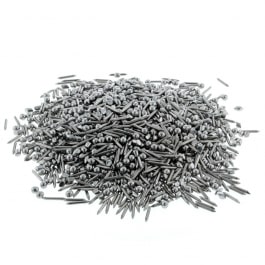







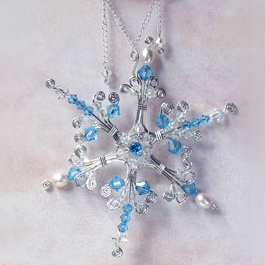 Faeries Frost
Faeries Frost Bird's Nest Pendant and Matching Earrings
Bird's Nest Pendant and Matching Earrings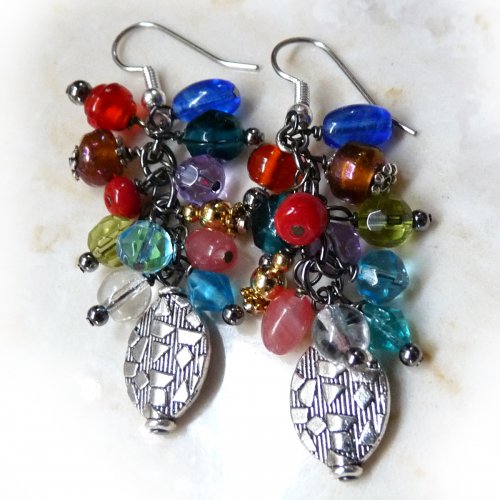 Beaded Cluster Earrings
Beaded Cluster Earrings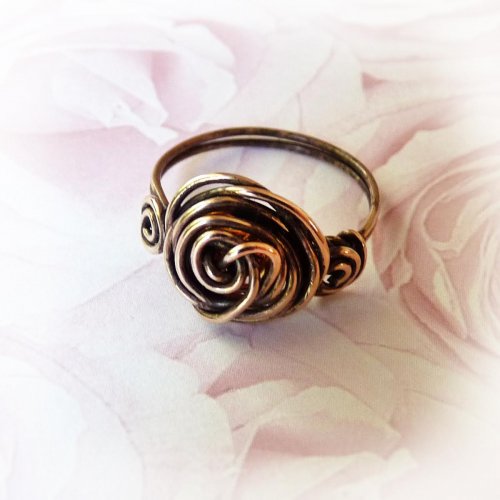 Romantic Roses Wire Ring
Romantic Roses Wire Ring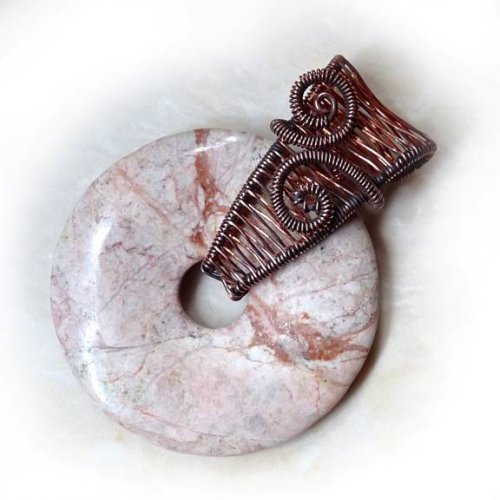 Woven Bail Donut Pendant
Woven Bail Donut Pendant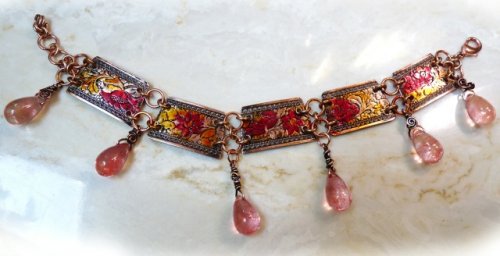 Creating Bracelets with Pattern Wire
Creating Bracelets with Pattern Wire
